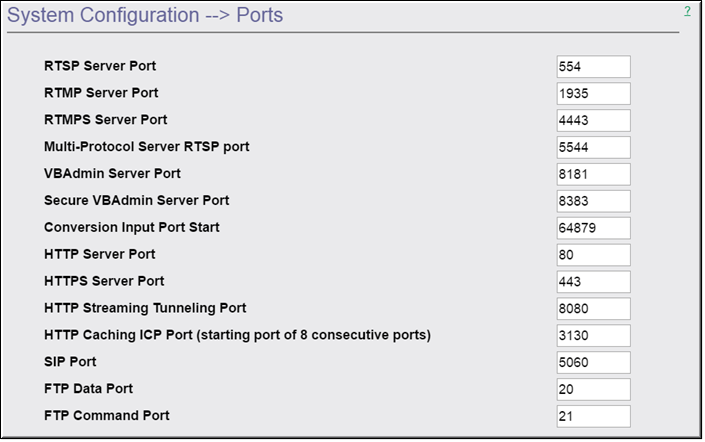
Field | Description |
RTSP Server Port | Default = 554. RTSP port for VOD streams from RTP server. Cannot be changed. Used to receive an RTP Auto Unicast stream as input and to serve RTSP RTP clients for output |
RTMP Server Port | Default = 1935. RTMP port for Flash VOD streams from RTMP server. Allows RTP streams as input. For example a VBrick H.264 encoder can be an RTMP input stream. |
RTMPS Server Port | Default = 4443. Secure Flash alternate of RTMP. |
Multi‑Protocol Server RTSP port | Default = 5544. The port number used by the Multi‑Protocol Server to listen for announcements. |
RTMP Server Announce Listener Port | Default = 5544. Allows for listening for auto unicast sessions from RTSP clients. Lets you send RTP streams to an RTMP streaming server via Auto Unicast (for transmuxing to Flash, HLS, or TS). Also allows TS streams to be served via RTSP on this port. |
VBAdmin Server Port | Default = 8181. Specifies the listener port for HTTP management connections as follows: http://IPaddress:port where IPaddress = DME IP address or hostname, and port. The port number can be moved to another port if required as long as it does not conflict with another existing port in the system. |
Conversion Input Port Start | Default = 64879. The starting port number used by the Stream Conversion feature. |
Secure VBAdmin Server Port | Default = 8383. Specifies the listener port for management and HTTPS connections. Used for HTTPS connections when enabled on the Security configuration page. Can be moved to another port number if required. |
HTTP Server Port | Default = 80. Sets the port used for progressive download (HTTP), HLS streams, and Caching. This port can be 80 or a safe port in the range 1025–65535. An error message will indicate an invalid port. |
HTTPS Server Port | Default=443 Secure HTTP port |
HTTP Streaming Tunneling Port | Default = 8080. Sets the port for HTTP tunneling via RTSP. The default is 8080 but if you are streaming HTTP directly from a DME via the Internet, it is a common practice to change this to 80 and to set any other service using port 80 to a different port. If you change this value you will need to make a comparable change on the player and on the DME configuration (i.e. HTTP Tunnel Port) in VEMS. |
HTTP Caching ICP Port (starting port of 8 consecutive ports) | This defines the starting port of a range of 8 consecutive UPD ports used for ICP. This value sets the ports used to discover multiple web caches on the local (source) DME and on remote DMEs. The default UDP port is 3130, and it is highly recommended that this value is not changed. Changing this port will impact DME shared caching (MESH). If you must change this range of ports, then it must be changed (to the same value) on ALL DMEs within your deployment. |
SIP Port | Default = 5060. The Session Initiation Protocol (SIP) port is used as a communication signaling port for VCGW features of the DME. |
FTP Data Port | Default = 20. Defined for FTP data port; works for FTPS as well. |
FTP Command Port | Default = 21. Defined for FTP command port; works for FTPS as well. The FTP client that connects to the DME must use ACTIVE mode to utilize this port. |
Note: For correct operation of the DME Mesh and shared caches, do not change the HTTP and HTTP default ports. Additionally, changing the HTTP Caching ICP Port must be changed on ALL DMEs and is therefore not recommended. |